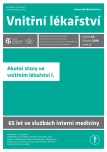Initial antibiotic treatment of serious bacterial infections
Authors:
Jiří Beneš
Authors‘ workplace:
Klinika infekčních nemocí 3. LF UK a Nemocnice Na Bulovce, Praha
Published in:
Vnitř Lék 2019; 65(3): 204-209
Category:
Overview
The article summarizes the known facts regarding the selection of antibiotics for the treatment of sepsis and similar serious infections, their mechanism of action, dosage and mode of administration. Particular attention is paid to early antibiotic therapy: a delay of several hours in the onset of antibiotic therapy can be tolerated if it helps to clarify the aethiology and to refine the treatment. However, in case of the very acute infections it is necessary to start antibiotic treatment immediately; diagnostic procedures are mentioned that can be used for the selection of the appropriate drug.
Keywords:
antibiotic treatment – initial treatment – loading dose – peracute infection
Sources
-
Kumar A, Roberts D, Wood KE et al. Duration of hypotension before initiation of effective antimicrobial therapy is the critical determinant of survival in human septic shock. Crit Care Med 2006; 34(6): 1589–1596. Dostupné z DOI: <http://dx.doi.org/10.1097/01.CCM.0000217961.75225.E9>.
-
Ferrer R, Martin-Loeches I, Phillips G et al. Empiric antibiotic treatment reduces mortality in severe sepsis and septic shock from the first hour: results from a guideline-based performance improvement program. Crit Care Me 2014; 42(8): 1749–1755. Dostupné z DOI: <http://dx.doi.org/10.1097/CCM.0000000000000330>.
-
Rhodes A, Evans LE, Alhazzani W et al. Surviving Sepsis Campaign: International Guidelines for Management of Sepsis and Septic Shock: 2016. Crit Care Med 2017; 45(3): 486–552. Dostupné z DOI: <http://dx.doi.org/10.1097/CCM.0000000000002255>.
-
Ryoo SM, Kim WY, Sohn CH et al. Prognostic value of timing of antibiotic administration in patients with septic shock treated with early quantitative resuscitation. Am J Med Sci 2015; 349(4): 328–333. Dostupné z DOI: <http://dx.doi.org/10.1097/MAJ.0000000000000423>.
-
Puskarich MA, Trzeciak S, Shapiro NI et al. Association between timing of antibiotic administration and mortality from septic shock in patients treated with a quantitative resuscitation protocol. Crit Care Med 2011; 39(9): 2066–2071. Dostupné z DOI: <http://dx.doi.org/10.1097/CCM.0b013e31821e87ab>.
-
de Groot B, Ansems A, Gerling DH et al. The association between time to antibiotics and relevant clinical outcomes in emergency department patients with various stages of sepsis: a prospective multi-center study. Crit Care 2015; 19: 194. Dostupné z DOI: <http://dx.doi.org/10.1186/s13054–015–0936–3>.
-
Alam N, Oskam E, Stassen PM et al. Prehospital antibiotics in the ambulance for sepsis: a multicentre, open label, randomised trial. Lancet Respir Med 2018; 6(1): 40–50. Dostupné z DOI: <http://dx.doi.org/10.1016/S2213–2600(17)30469–1>.
-
Bolliger R, Merker M, Schuetz P. Use of antibiotics in the ambulance for sepsis patients: is earlier really better? J Thorac Dis 2018; 10(3): 1239–1241. Dostupné z DOI: <http://dx.doi.org/10.21037/jtd.2018.02.49>.
-
Singer M, Deutschman CS, Seymour CW et al. The Third International Consensus Definitions for Sepsis and Septic Shock (Sepsis-3). JAMA 2016; 315(8): 801–810. Dostupné z DOI: <http://dx.doi.org/10.1001/jama.2016.0287>.
-
Bone RC, Balk RA, Cerra FB et al. Definitions for sepsis and organ failure and guidelines for the use of innovative therapies in sepsis. The ACCP/SCCM Consensus Conference Committee. American College of Chest Physicians/Society of Critical Care Medicine. Chest 1992; 101(6): 1644–1655.
-
Beneš J. Antibiotika: systematika, vlastnosti, použití. Grada: Praha 2018. ISBN 978–80–271–0636–3.
-
Zaske DE, Cipolle RJ, Rotschafer JC et al. Gentamicin pharmacokinetics in 1,640 patients: method for control of serum concentrations. Antimicrob Agents Chemother 1982; 21(3): 407–411.
-
Zaske DE, Sawchuk RJ, Gerding DN et al. Increased dosage requirements of gentamicin in burn patients. J Trauma 1976; 16(10): 824–828.
-
Felton TW, Hope WW, Roberts JA. How severe is antibiotic pharmacokinetic variability in critically ill patients and what can be done about it? Diagn Microbiol Infect Dis 2014; 79(4): 441–447. Dostupné z DOI: <http://dx.doi.org/10.1016/j.diagmicrobio.2014.04.007>.
-
Parker SL, Sime FB, Roberts JA. Optimizing dosing of antibiotics in critically ill patients. Curr Opin Infect Dis 2015; 28(6): 497–504. Dostupné z DOI: <http://dx.doi.org/10.1097/QCO.0000000000000206>.
-
Tängdén T, Ramos Martín V, Felton TW et al. The role of infection models and PK/PD modelling for optimising care of critically ill patients with severe infections. Intensive Care Med 2017; 43(7): 1021–1032. Dostupné z DOI: <http:///dx.doi.org/10.1007/s00134–017–4780–6>.
-
Chant C, Leung A, Friedrich JO. Optimal dosing of antibiotics in critically ill patients by using continuous/extended infusions: a systematic review and meta-analysis. Crit Care 2013; 17(6): R279. Dostupné z DOI: <http://dx.doi.org/10.1186/cc13134>.
-
Shiu J, Wang E, Tejani AM et al. Continuous versus intermittent infusions of antibiotics for the treatment of severe acute infections. Cochrane Database Syst Rev 2013; (3): CD008481. Dostupné z DOI: <http://dx.doi.org/10.1002/14651858.CD008481.pub2>.
-
Sechser T. Farmakokinetika pro lékaře. Část IV – Biologický poločas. Remedia 1992; 2(6): 312–315.
-
Reardon J, Lau TT, Ensom MH. Vancomycin loading doses: a systematic review. Ann Pharmacother 2015; 49(5): 557–565. Dostupné z DOI: <http://dx.doi.org/10.1177/1060028015571163>.
-
Tkadlec J, Melter O. Trpasličí kolonie Staphylococcus aureus. Klin Mikrobiol Infekc Lek 2013; 19(3): 96–102.
-
Beneš J, Džupová O. Bakterie tvořící drobné kolonie (small-colony variants) jako původci infekční endokarditidy a dalších závažných infekcí. Klin Mikrobiol Infekc Lék 2013; 19(2): 56–61.
-
Bennett JE, Dolin R, Blaser MJ (eds). Principles and Practice of Infectious Diseases. 8th ed. Elsevier Saunders 2015. ISBN 9781455748013.
-
Cohen J, Powderly WG, Opal SM et al (eds). Infectious Diseases. 2 voll. 4th ed. Elsevier 2017. ISBN 9780702062858.
Labels
Diabetology Endocrinology Internal medicineArticle was published in
Internal Medicine

2019 Issue 3
Most read in this issue
- Hemorrhagic shock and treatment of severe bleeding
- Intravenous fluid therapy in acutely ill patients for non-intensivists
- Acute respiratory distress syndrome
- Diagnosing hypovolemia and hypervolemia: from clinical examination to modern methods
